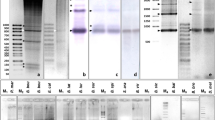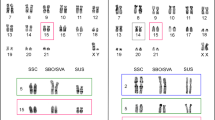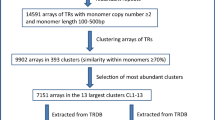Abstract
Bovine satellite I DNA was shown by its susceptibility to cleavage by restriction endonucleases to consist of direct tandem repeats 1,400 base pairs in length. Renaturation kinetics indicate that this repeat is itself internally repetitious. These data argue in favour of a DNA replication mechanism for the evolution of this satellite.
This is a preview of subscription content, access via your institution
Access options
Subscribe to this journal
Receive 51 print issues and online access
$199.00 per year
only $3.90 per issue
Buy this article
- Purchase on Springer Link
- Instant access to full article PDF
Prices may be subject to local taxes which are calculated during checkout
Similar content being viewed by others
References
Chromosome Identification, edit. by Caspersson, T., and Zech, L., (Nobel Symposia 23), (Academic Press, London and New York, 1973).
Sumner, A. T., and Evans, H. J., Expl Cell Res., 81, 223–236 (1973).
McKay, R. D. G., Chromosoma, 44, 1–14 (1973).
Prescott, D. M., Bostock, C. J., Hatch, F. T., and Mazrimas, J. A., Chromosoma, 42, 205–213 (1973).
McGregor, H. C., Horner, H., Owen, C. A., and Parker, I., Chromosoma, 43, 329–348 (1973).
Botchan, M. R., Kram, R., Schmid, C., and Hearst, J. E., Proc. natn. Acad. Sci. U.S.A., 68, 1125 (1971).
Sutton, W. D., Nature new Biol., 237, 70–71 (1972).
Gall, J. G., Cohen, E. H., and Polan, M. L., Chromosoma, 33, 319–344 (1971).
Jones, K. W., Nature, 225, 912 (1970).
Waring, M., and Britten, R. J., Science, 154, 791–794 (1966).
Southern, E. M., Nature, 227, 794–798 (1970).
Walker, P. M. B., in Prog. Biophys. molec. Biol., 23, 145 (Academic Press, New York, 1971).
Fry, K., Poon, R., Whitcome, P., Idriss, J., Salser, W., Mazrimas, J., and Hatch, F., Proc. natn. Acad. Sci. U.S.A., 70, 2642–2646 (1973).
Gall, J. G., and Atherton, D., J. molec. Biol. (in the press).
Britten, R. J., and Smith, J., Carnegie Yearbook, 68, 378–386 (1969).
Kurnit, D. M., Shafit, B. R., and Maio, J. J., J. molec. Biol., 81, 273–284 (1973).
Filipski, J., Thiery, J. P., and Bernardi, G., J. molec. Biol., 80, 177–197 (1973).
Corneo, G., Ginelli, E., and Polli, E., Biochemistry, 9, 1565–1571 (1970).
Yasmineh, W. G., and Yunis, J. J., Expl Cell Res., 64, 41–48 (1971).
Smith, H., and Nathans, D., J. molec. Biol., 81, 419 (1973).
Hedgpeth, J., Goodman, H. M., and Boyer, H. W., Proc. natn. Acad. Sci. U.S.A., 69, 3448 (1972).
Pettersson, U., Mulder, C., Delius, H., and Sharp, P. A., Proc. natn. Acad. Sci. U.S.A., 70, 200–204 (1973).
Wetmur, J. C., and Davidson, N., J. molec. Biol., 31, 349–370 (1968).
Britten, R. J., and Kohne, D., Science, 161, 529 (1968).
Smith, H. O., and Wilcox, K. W., J. molec. Biol., 51, 379–391 (1970).
Hennig, W., Hennig, I., and Stein, H., Chromosoma, 32, 31–63 (1970).
Mazrimas, J. A., and Hatch, F. T., Nature new Biol., 240, 102 (1972).
Blumenfeld, M., Fox, A. S., and Forrest, H. S., Proc. natn. Acad. Sci. U.S.A., 70, 2772–2775 (1973).
Sutton, W. D., and McCallum, M., J. molec. Biol., 71, 633–656 (1972).
Smith, G., Cold Spring Harb. Symp. quant. Biol., 38 (in the press).
Jones, K. W., and Corneo, G., Nature new Biol., 233, 268–271 (1971).
Craig, A. P., and Shaw, M. W., Science, 174, 702–704 (1971).
Hourcade, D., Dressler, D., and Wolfson, J., Proc. natn. Acad. Sci. U.S.A., 70, 2926 (1973).
Bird, A. J., Rochaix, J. D., and Bakken, A., in Molecular Cytogenetics (Plenum Press, New York, in the press).
Botchan, M., McKenna, G., and Sharp, P. A., Cold Spring Harb. Symp. quant. Biol., 38, 383–395 (1974).
Sharp, P. A., Sugden, B., and Sambrook, J., Biochemistry, 12, 3055–3063 (1973).
Danna, K., and Nathans, D., Proc. natn. Acad. Sci. U.S.A., 68, 2913–2917 (1971).
Author information
Authors and Affiliations
Rights and permissions
About this article
Cite this article
Botchan, M. Bovine satellite I DNA consists of repetitive units 1,400 base pairs in length. Nature 251, 288–292 (1974). https://doi.org/10.1038/251288a0
Received:
Revised:
Issue Date:
DOI: https://doi.org/10.1038/251288a0
This article is cited by
-
The bovine bivariate flow karyotype and peak identification by chromosome painting with PCR-generated probes
Mammalian Genome (1995)
-
The heterochromatin of grasshoppers from the Caledia captiva species complex
Chromosoma (1986)
-
The heterochromatin of grasshoppers from the Caledia captiva species complex
Chromosoma (1985)
-
Hinf family: a novel repeated DNA family of the human genome
Nature (1983)
-
A multicopy insertion sequence in the bovine genome with structural homology to the long terminal repeats of retroviruses
Nature (1982)
Comments
By submitting a comment you agree to abide by our Terms and Community Guidelines. If you find something abusive or that does not comply with our terms or guidelines please flag it as inappropriate.



